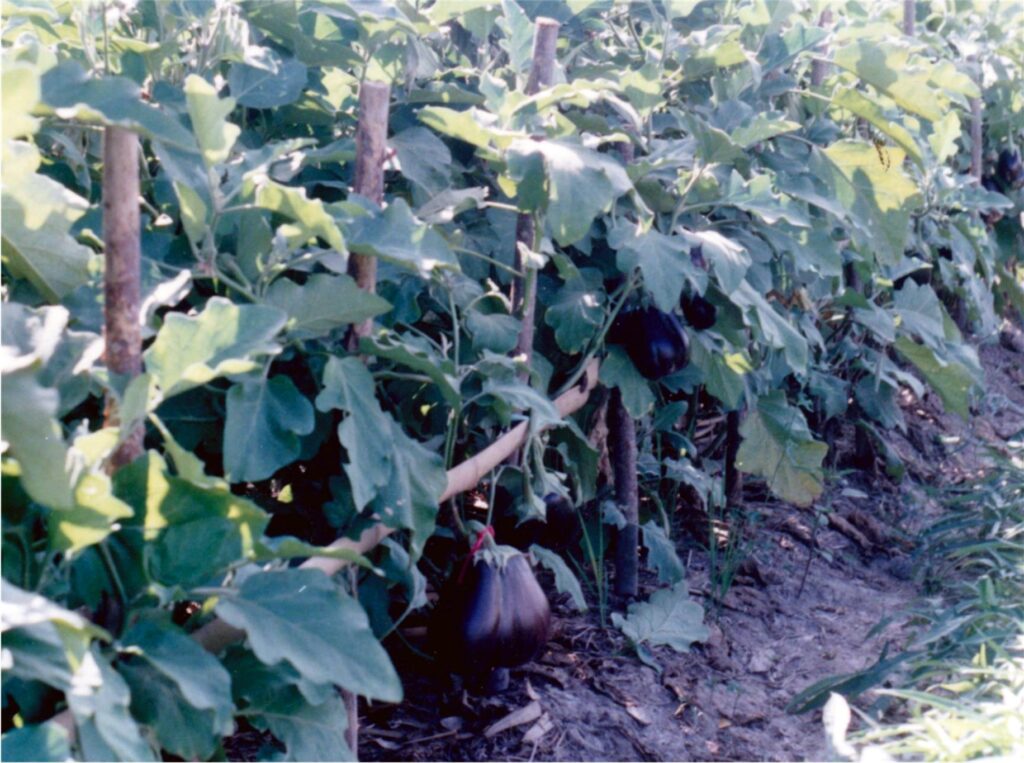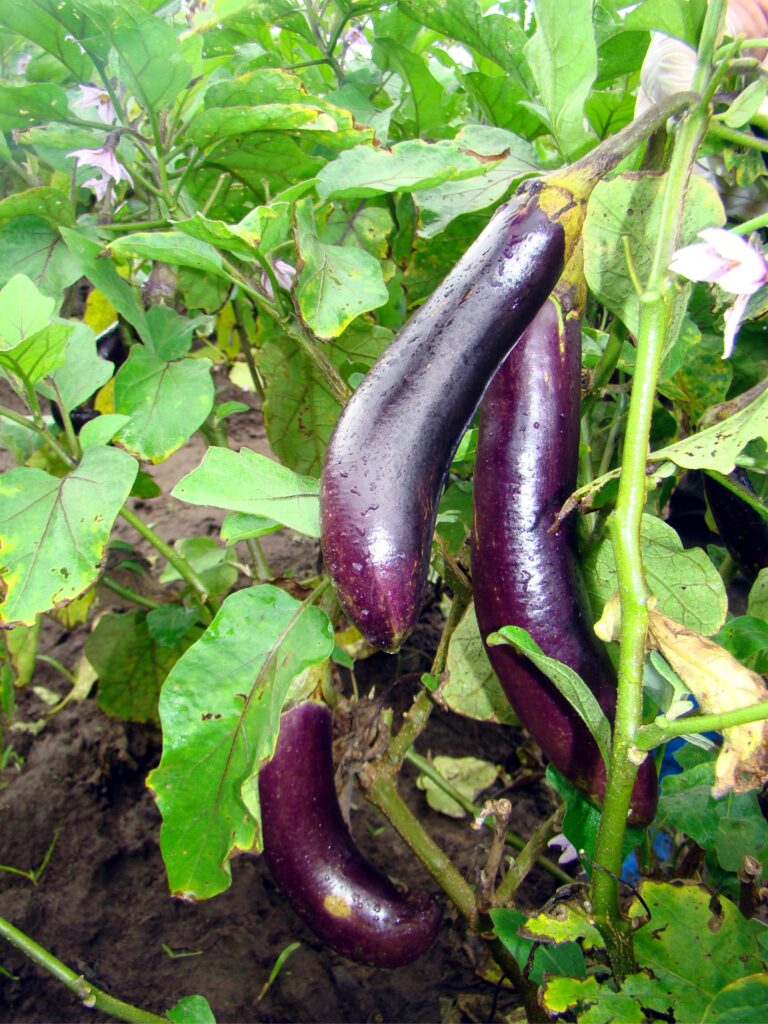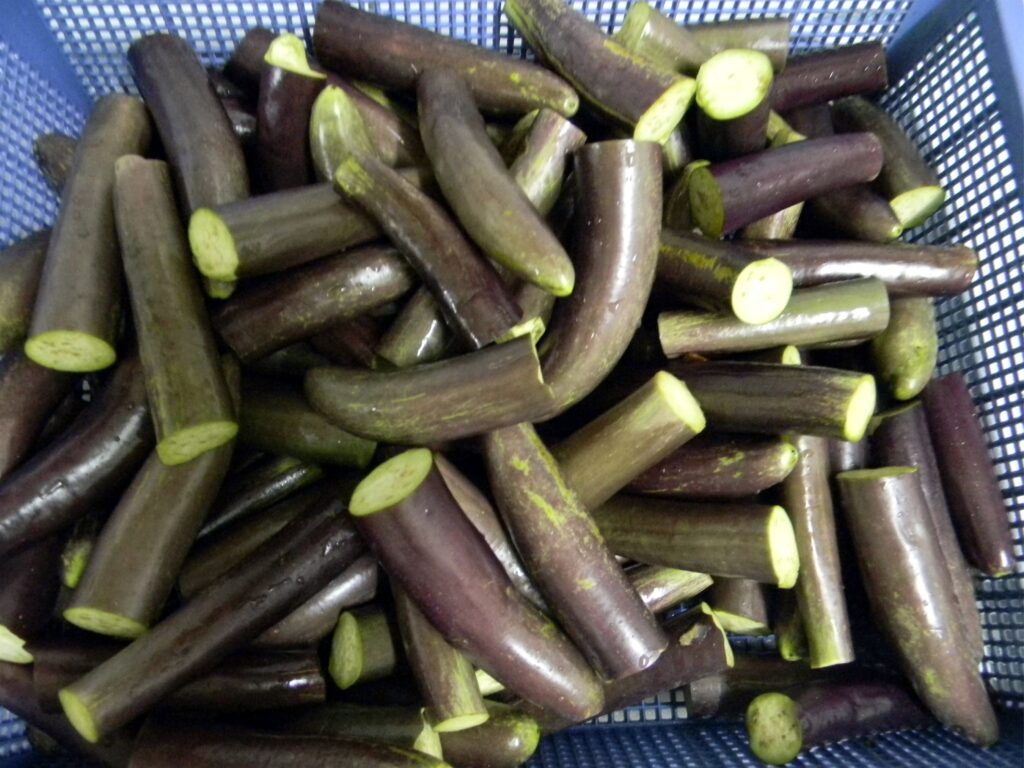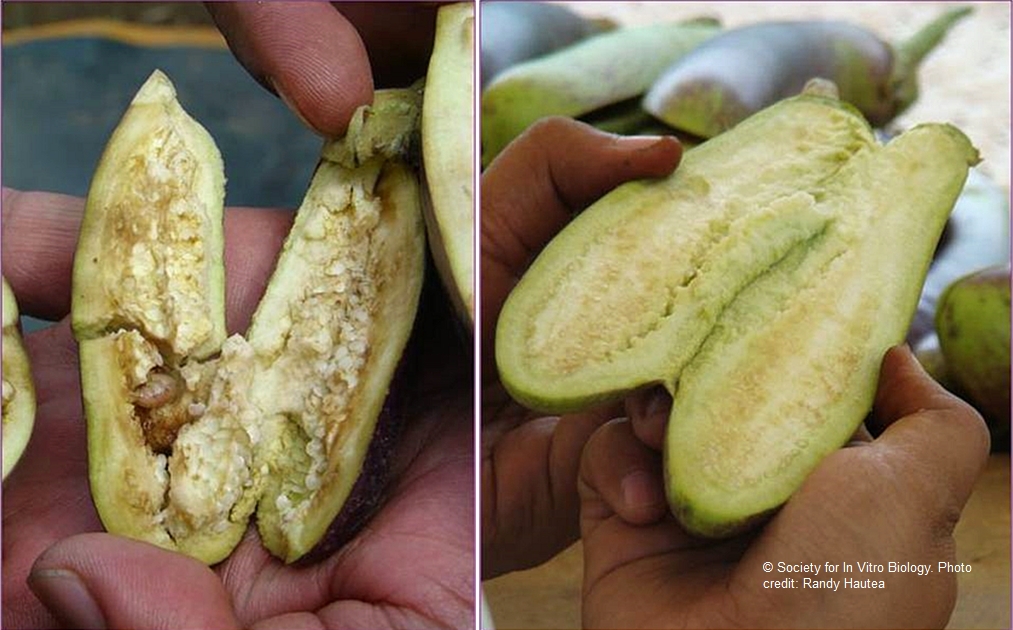Text and Photo by Henrylito D. Tacio
Additional Photos from ISAAA
Around the world, eggplant is used in various cuisines. It can be sliced, battered, and deep-fried, and then served with various sauces. Grilled and mashed eggplant mixed with onions, tomatoes, and spices makes the Indian dish baingan ka bhartha. The eggplant can also be stuffed with meat, rice, or other fillings and then baked.
Eggplant can also be found in a few Chinese dishes, like braised eggplant and stuffed eggplant. In the United States, eggplant is best steamed or baked. Cheese and tomatoes are added for flavoring. In the Philippines, eggplant is one of the main ingredients of pinakbet, torta, sinigang, ensalada, and kare-kare.
The popularity of eggplant is the reason why it is the number one vegetable in the country – in terms of area planted (20,000 hectares) and volume of production (179,000 metric tons). Most of the top producing regions are located in Luzon like Ilocos, Central Luzon, Cagayan Valley, CALABARZON (composed of Cavite, Laguna, Batangas, Rizal, and Quezon) and Bicol.
Resource-poor farmers in many provinces grow eggplant and depend on it for their livelihood. One of them is Edgar C. Talasan, a vegetable farmer from barangay Imalutao in Impasug-ong, Bukidnon. At one time, he planted 2,500 eggplants on his farm. In just one crop cycle, he got a gross income of P84,000.
From the income of his farm, he was able to raise his family well. In fact, he sent his daughter through college by selling the vegetables harvested from his farm. “I was happy and content in my little kingdom,” he said.
But what makes him sad is the fact that eggplant production in the country suffers a severe yield loss from insect pests, diseases, and extreme environmental conditions. In a technology forum he attended in Pangasinan, he realized that eggplant growers sprayed their crops with chemicals once a day to protect the eggplants from infestation.
The most destructive insect pest that attacks the crop is called the eggplant fruit and shoot borer (EFSB). Scientifically, it is called Leucinodes orbonalis, a moth species prevalent in Asia and Africa. The moths’ larvae feed on eggplant shoots and fruits until maturity.
“The EFSB can cause as much as 50-75 percent loss of fruits,” said former Science Secretary Emil Q. Javier. “The worm of the insect bore tunnels in the fruit, rendering them unfit for consumption.”
Unfortunately, there is no known genetic resistance to EFSB in cultivated and wild eggplants. “The insects are concealed in the shoots and fruits and are difficult to reach,” Dr. Javier explained.
To reduce the population of EFSB, some farmers practice integrated pest management, which includes: regular crop rotation or intercropping eggplant with other vegetables; removal and burying of infested and damaged shoots and fruits; and using nylon net barriers to protect plants from the insects.

Eggplant new 
Bt talong (Photo courtesy of SEARCA)
Other farmers employ the following: using light or pheromone traps; growing eggplants in a screen house before transplanting in their farms; and conservation of beneficial arthropods (spiders, parasitoids, and predators).
But there are farmers who spray their eggplants almost every other day with insecticides to protect the crops.
In his 15 years of vegetable farming, Talasan said that in every eggplant cropping cycle, he sprayed at least twice a week. For every 1,000 eggplant hills, he used 0.5 kilograms of Lannate, two bottles (250 mL) of Prevathon, two bottles (250 mL) of Alika, one liter of Karate, one kilogram of Daconil, and 0.5 liters of Selecron.
The current method of spraying chemicals to eggplants in order to control EFSB is unacceptable, according to Dr. Emiliana Bernardo, an entomologist or a scientist who studies insects.
The practice is also unhealthy to consumers, farmers, and the environment, said Dr. Bernardo, who is also a member of the Institutional Biosafety Committee of the University of the Philippines Los Baños.
She said studies conducted in major eggplant-producing provinces found that almost all farmers use chemical insecticides and that some even dip the unharvested eggplant fruits in a mix of chemicals just to ensure that harvests are marketable.
“The very basic question is, which is safer, the present practice or the alternative, the Bt eggplant which is rigorously evaluated by experts?” she asked. “Is bathing the unharvested eggplant fruits in chemicals, which would end up in people’s dinner tables, safe?”
Are there other ways of controlling EFSB? Scientists who tried various methods came up with Bt eggplant. Bt stands for Bacillus thuringiensis.
“Bt talong was developed by genetically engineering a gene from the bacteria so that the genetically modified eggplants now produce a protein that defends it against insect attacks,” explained Dr. Michael Purugganan, a Filipino plant geneticist who is the Dean of Science at the New York University.
“When ingested by the larvae of the target insect, the Bt protein is activated in the gut’s alkaline condition and punctures the mid-gut leaving the insect unable to eat. The insect dies within a few days,” noted a briefing paper circulated by the Laguna-based International Service for the Acquisition of Agri-biotech Applications (ISAAA).
Bt is present in the Philippine soil and has been in use for years without any harmful effects. As it comes from the earth itself, Bt is very natural, according to Dr. Bernardo. In 1901, Bt was discovered to have an insecticidal property. By the 1950s, it became a well-known biological insecticide.
“Bt is easily cultured by fermentation,” the ISAAA briefing paper said. “Thus, over the last 40 years, Bt has been used as an insecticide by farmers worldwide. Organic farming has benefited from Bt insecticide, as it is one of the very few pesticides permitted by organic standards. The insecticide is applied either as a spray or as ground applications. It comes in both granules and liquefied form.”
The first Bt eggplant was developed by the Indian Maharashtra Hybrid Seeds Company Limited (Mahyco). The Institute of Plant Breeding at the University of the Philippines at Los Baños (UPLB) has developed the Bt eggplant in the country, in partnership with Mahyco and Cornell University and with support from the United States Agency for International Development (USAID).
The ISAAA says that before Bt eggplant is approved for commercial use, scientists and regulators ensure that it passes through many tests and safety assessments. In the Philippines, the biosafety of Bt crops is evaluated by a pool of technical scientists in five stages: contained research in laboratories and screen houses; small limited, confined field trials; multi-location field trials; food, feed, and processing; and commercial propagation.
Last July, the Bureau of Plant Industry (BPI) – a line agency of the Department of Agriculture – approved Bt eggplant for direct use as food, feed, and for processing (FFP). In issuing Biosafety Permit No. 21-078FFP, it is found “to be safe as conventional eggplant” and “can substitute for its traditional counterpart.”

“(Right now, Bt eggplant is) still considered as a regulated material, no commercial planting is allowed, as stipulated in the biosafety permit conditions,” replied Dr. Lourdes D. Taylo, study leader of the Bt eggplant project from UPLB, in an e-mail interview.
She, however, hopes that “by the last quarter of 2022, Bt talong will be finally approved and will be made available to eggplant farmers in the Philippines.”
Vegetable farmers need not to worry when it comes to planting eggplant. “There are no differences in the production practices (fertilizer application, weeding, irrigation) used in growing of Bt eggplant compared to conventional eggplant except in insecticide application against the borer,” Dr. Taylo said.
A recent study showed that Bt eggplant could bring health cost savings of P9.33 million yearly from its nearly pesticide-free use. Researcher Sergio R. Francisco has estimated savings in a survey of long exposure to pesticide spraying against the highly-infested EFSB in his study, “Health and Environmental Impacts of Bt Eggplant.”
The study was based on the perception of 100 eggplant farmers from Batangas, Nueva Ecija, Pangasinan, and Quezon who sprayed their eggplant. These farmers have a long experience in farming – from 9.96 to 18.04 years.
In a press statement, it was disclosed that the benefit to human health from health cost savings in growing Bt eggplant is equivalent to P2.49 million yearly as risk from illnesses is avoided. For farm animals, the projected benefit per year is at P2.12 million.
For beneficial insects, the environmental benefit is valued at P2.45 million yearly, and for bird species, P2.27 million – as these are saved from death, thereby contributing to biodiversity enhancement.
In the meantime, farmers are waiting for its approval for commercialization. “We are hoping it will be released soon so that we can benefit from it already,” some farmers told ISAAA.
Dr. Taylo echoed the same concern. “Bt eggplant is an important technology that has been proven to work well and hopefully would be soon made available to the farmers,” she pointed out.

